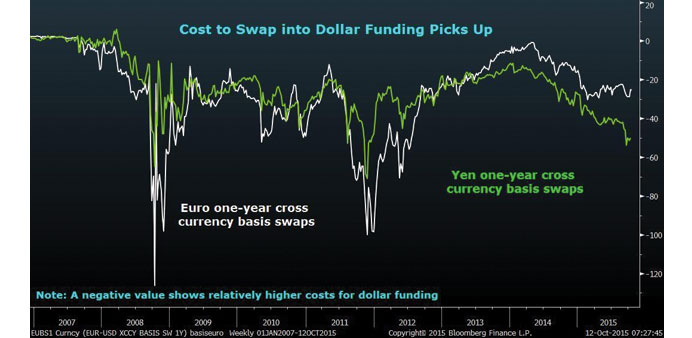Bloomberg
New York
Corporate America’s binge on debt in euros has left it with indigestion.
The European Central Bank’s efforts to stimulate borrowing and lending have been so effective they’ve drawn US companies to issue €89bn ($101bn) of bonds denominated in the shared currency this year, the most since 2007, according to data compiled by Bloomberg.
The flipside is so many US companies have been borrowing in euros to take advantage of historically low interest rates that the cost to swap those proceeds back into dollars has surged to the highest since 2012. With Federal Reserve policy makers still expecting to raise interest rates before year end and speculation building Europe will have to boost stimulus efforts, the bottleneck looks to only get worse.
“There is just too much money in euros and yen relative to what’s going on in the dollar market,” said David Keeble, head of US rates strategy at Credit Agricole.
The cost to obtain dollars in the basis swaps market, where floating payment streams in different currencies are exchanged, doesn’t have a direct impact on the value of foreign-exchange rates. It does reveal a continued faith in the US economy as the place where interest rates are most likely to rise and there will be opportunities for cash to be deployed, Keeble said.
That faith has recently been shaken in the currency market itself. The dollar declined against 15 of its 16 major peers during the past month as the Fed refrained from raising rates at its September meeting and US job creation trailed forecasts.
Over the past 12 months, the US currency outperformed all 16, according to data compiled by Bloomberg.
In an effort to capture relatively low borrowing costs, Apple sold €2bn of debt in September, Bloomberg data show. Time Warner sold its first bonds in euros in July, raising €700mn of bonds due September 2023.
The resulting cash available in foreign currencies has made companies willing to pay up in swaps markets to convert those flows back into needed dollar streams. A negative swap rate indicates companies are willing to receive reduced interest payments on the euros they lend in order to obtain the needed financing in dollars.
The one-year cross-currency basis swaps rate between euros and dollars was negative 25 basis points on Friday. The rate was near the negative 33 basis points reached in June that was the largest effective premium for dollar borrowing in swaps since the third quarter 2012, when concern the shared currency would cease to exist altogether was at its height.
“There is a relative dollar shortage, with this time around, it’s more about an oversupply of other currencies,” said Priya Misra, the head of global interest-rate strategy in New York at Toronto-Dominion Bank. Unprecedented stimulus in Japan has also attracted US companies to borrow in yen. Procter & Gamble Co sold 100bn of yen-denominated notes in April.
That, in turn, pushed the cost of switching yen payments to the highest last month in four years. The effective premium companies are paying to swap yen-based funding for that in US dollars reached negative 60 basis points on September 21, the most since November 2011.
The current premium falls short of conditions following the collapse of Lehman Brothers Holdings in 2008. European financial institutions, which at that time owned more than $800bn in dollar-denominated investments, paid a record amount to get needed dollars during the near credit freeze.
At the time, the euro-to-dollar basis rate reached negative 138 basis points, the most extreme since the introduction of the shared currency in 1999. The rate averaged close to zero between 1999 and the start of the financial crisis.
The increase in the cost of swaps this year should act as a natural break to foreign debt issuance, TD’s Misra said. At the same time, more quantitative easing in Europe or higher interest rates in the US may keep the swap costs high for companies, she said.
“The Fed is on the way to hike, while the ECB is probably on the way to expand its QE, so you’re talking about the decline in dollar liquidity relative to euro cash liquidity,” Ruslan Bikbov, a rates derivative strategist at Bank of America Corp “There is certainly demand for the dollar.”



